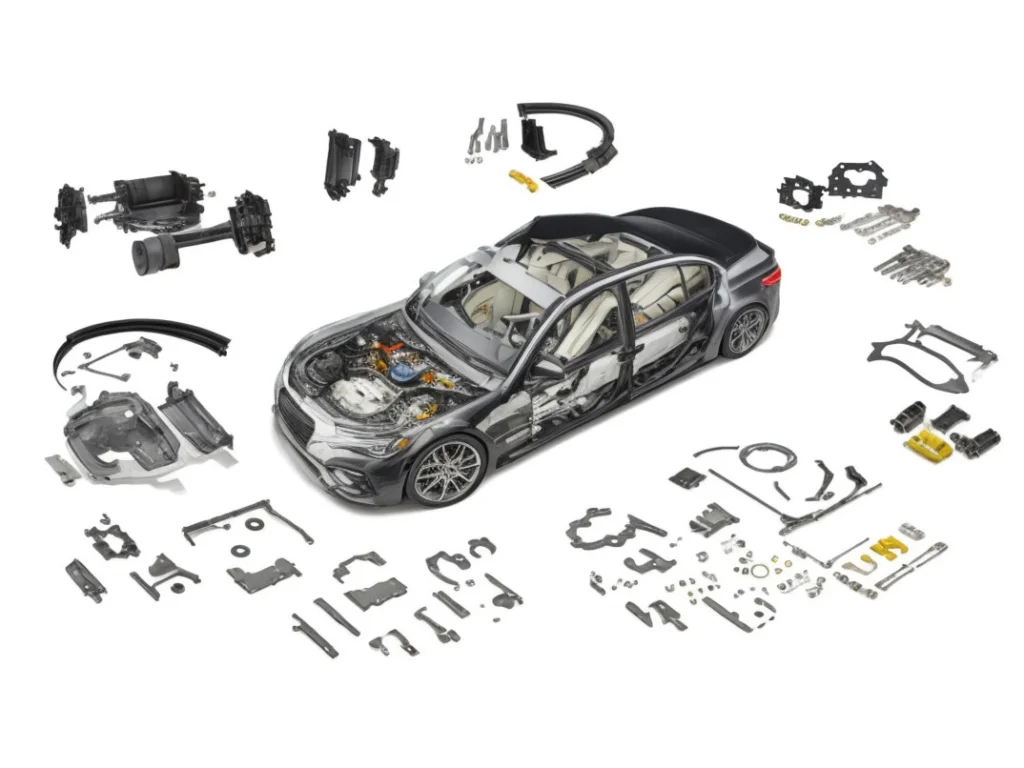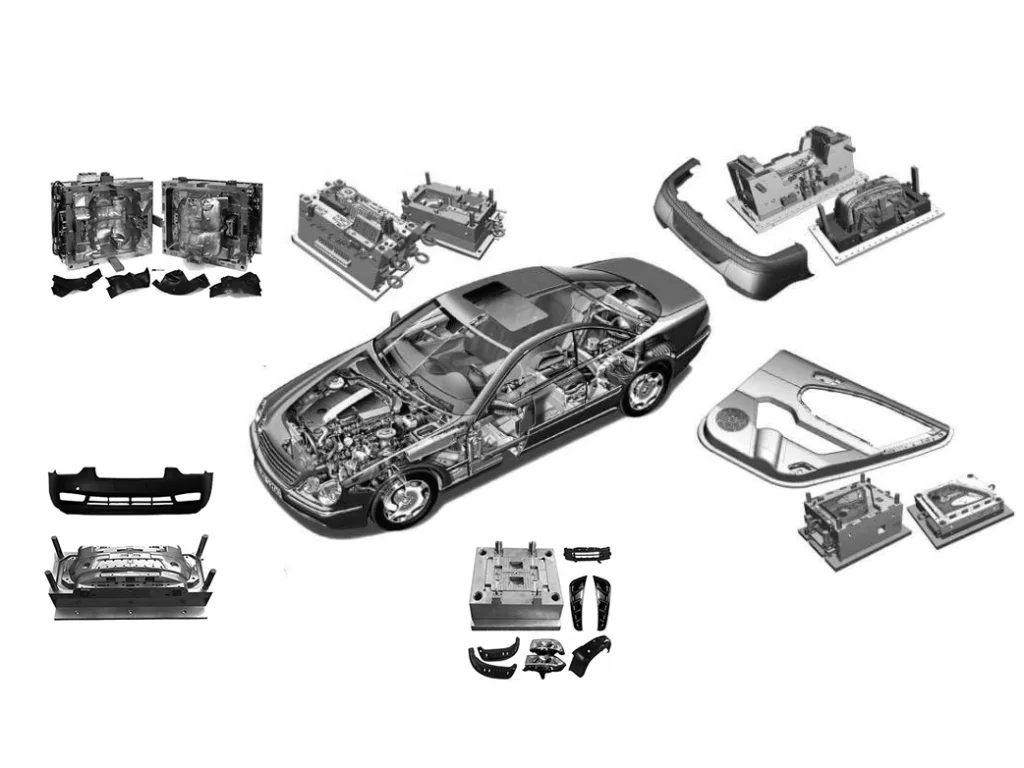Automotive injection molding is increasingly used in the automotive manufacturing industry because of automotive injection molding benefits. Automotive injection molding is famous for its efficiency, precision, and versatility. This process allows for the mass production of intricate components with consistent quality and tight tolerances, making it ideal for automotive applications.
In this post, we will delve deeper into the myriad benefits of automotive injection molding. From lightweight components to rapid prototyping capabilities, automotive injection molding continues to shape the future of automotive manufacturing in profound ways.
The Automotive Injection Molding Benefits
Automotive injection molding offers numerous benefits making it a preferred manufacturing method for various components. Here are some of the key benefits:
Light weight Design
One of the primary advantages of automotive injection molding is its ability to produce intricate parts with minimal material usage. This efficiency not only reduces manufacturing costs but also contributes to significant weight savings throughout the vehicle. Plastic parts produced through injection molding are significantly lighter than metal alternatives, contributing to reduced vehicle weight. This helps improve fuel efficiency without sacrificing power or performance, while also reducing emissions.
Interior Panels: Interior components such as door panels, dashboard trim, and center consoles are commonly manufactured using injection-molded plastics. These parts not only contribute to a reduction in vehicle weight but also offer designers the flexibility to incorporate innovative features and aesthetics without adding bulk.
Bumpers: Modern automotive bumpers are often composed of lightweight yet impact-resistant plastics produced through injection molding. These bumpers not only enhance vehicle safety but also contribute to improved fuel efficiency by minimizing weight at the front and rear ends of the vehicle.
Under-the-Hood Parts: Various under-the-hood components, including engine covers, intake manifolds, and fluid reservoirs, are frequently manufactured using injection-molded plastics. These lightweight parts contribute to overall vehicle efficiency by reducing engine strain and improving aerodynamics.
Cost Efficiency at Mass Production
Compared to traditional manufacturing methods such as machining or casting, plastic injection molding stands out as a cost-effective manufacturing solution, particularly in the automotive industry, where efficiency and affordability are paramount.
Tooling Longevity and Cost Amortization: While the initial investment in mold tooling and injection molding equipment can be high, the cost per part becomes very low when producing at high volumes.
Reduced Material Waste: Injection molding minimizes material waste by precisely controlling the amount of plastic material injected into the mold cavity. This results in minimal excess material and fewer secondary operations required to achieve the desired part geometry.
Faster Production Cycles: Injection molding boasts rapid production cycles, allowing for high-volume manufacturing of automotive components within short lead times. The automated nature of injection molding machines ensures consistent part quality and throughput and maximizes production efficiency.
Lower Labor Costs: Automation injection molding significantly reduces the need for manual labor compared to traditional manufacturing methods. Once the mold design is finalized and the injection molding machine is set up, the production process can run efficiently with minimal human intervention.
Design Flexibility
Injection molding allows for greater design freedom compared to traditional manufacturing methods. Complex shapes, undercuts, and intricate features can be easily incorporated into injection-molded automotive components, automakers can experiment with the size and shape of components, making formerly impossible designs a reality.
Grilles and Ventilation Components: Automotive grilles and ventilation components often feature intricate patterns and designs to optimize airflow and enhance aesthetics.
Interior Trim and Surfaces: Interior trim panels, dashboard components, and center consoles in vehicles often feature intricate textures, patterns, and integrated functionalities.
Customized Features: Injection molding allows for the integration of customized features and branding elements directly into automotive components. This includes logos, emblems, and branding elements molded directly into parts, eliminating the need for secondary processes such as painting or adhesive application.
Enhanced Durability and Performance
Injection-molded automotive parts are highly durable and can last for decades. Unlike traditional materials such as metal or glass, modern thermoplastic materials used in injection molding are engineered to withstand harsh environmental conditions, impact forces, and wear, ensuring optimal performance throughout the vehicle’s lifecycle.
Such as ABS is renowned for its excellent impact resistance, making it an ideal choice for automotive components that are subjected to frequent impacts and vibrations, such as interior trim panels, dashboard components, and exterior body parts. Injection-molded polypropylene parts are commonly found in automotive interiors, including door panels, seat components, and storage compartments, where durability and resistance to wear and tear are paramount.
Consistent Quality and Precision
Injection molding ensures consistently high-quality parts with uniform thickness and close tolerances, meeting or exceeding industry standards. The use of robust metal molds guarantees that each part will be practically identical, ensuring repeatable performance.
Wide Range of Applications
Injection molding is versatile and can be used to produce a variety of automotive components, including interior parts (door panels, dashboards, air vents), exterior parts (bumpers, fenders, grilles), and under-the-hood components (battery casings, oil gauges).
The versatility of injection molding allows automotive manufacturers to efficiently produce a wide range of components with varying shapes, sizes, and functionalities, all while maintaining high levels of quality and consistency. Whether it’s enhancing interior comfort, improving exterior aesthetics, or ensuring reliable performance under the hood, injection molding plays a crucial role in meeting the diverse needs of today’s automotive industry.
 Application of Plastic Injection Molding in Automotive
Application of Plastic Injection Molding in Automotive
Various Materials Options
Automotive manufacturers have access to a diverse selection of thermoplastic and thermosetting materials, each offering unique properties and performance characteristics tailored to specific requirements. Here are some of the commonly used plastics in automotive injection molding:
Polypropylene (PP):
Polypropylene is widely used in automotive interiors for its excellent chemical resistance, low moisture absorption, and ability to withstand high temperatures. It is commonly used for interior trim panels, door panels, and storage compartments due to its lightweight and durable nature.
Acrylonitrile Butadiene Styrene (ABS):
ABS is prized for its exceptional impact resistance, toughness, and dimensional stability, making it suitable for both interior and exterior automotive components. It is commonly used for instrument panels, exterior body panels, and automotive grilles.
Polyethylene (PE):
Polyethylene is known for its low cost, flexibility, and resistance to moisture and chemicals. It is often used for automotive applications such as fuel tanks, fluid reservoirs, and under-the-hood components due to its excellent chemical resistance and durability.
Polyamide (PA/Nylon):
Polyamide offers high strength, heat resistance, and wear resistance, making it suitable for demanding automotive applications. It is commonly used for engine components, air intake manifolds, and structural parts requiring high mechanical properties.
Polycarbonate (PC):
Polycarbonate is prized for its transparency, impact resistance, and high-temperature performance, making it ideal for automotive lighting applications such as headlight lenses, taillight covers, and interior lighting components.
Polyurethane (PU):
Polyurethane offers excellent flexibility, abrasion resistance, and impact absorption properties, making it suitable for automotive seating, armrests, and other interior components requiring comfort and durability.
Polyethylene Terephthalate (PET):
PET is commonly used for automotive applications such as fuel lines, electrical connectors, and packaging due to its excellent chemical resistance, thermal stability, and low moisture absorption.
Thermoplastic Elastomers (TPE/TPU):
TPEs and TPUs offer the combined properties of rubber and plastic, including flexibility, resilience, and weather resistance. They are commonly used for automotive seals, gaskets, and weatherstripping to provide reliable sealing and insulation properties.
Conclusion
Automotive injection molding offers a multitude of benefits. From lightweight design and cost efficiency to design flexibility and enhanced durability, By leveraging the capabilities of injection molding, automotive manufacturers can produce high-quality parts with precision, consistency, and efficiency. The ability to choose from a wide range of materials, achieve complex geometries, and create various surface finishes empowers designers to innovate and optimize automotive components for performance, aesthetics, and functionality.




